January 04, 2011
By J. Guthrie
The .50 BMG is not the world's ultimate big-bore long-range cartridge, but the .416 Barrett very well could be.
By J. Guthrie
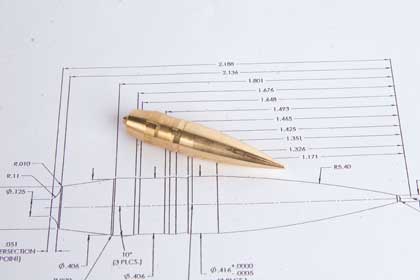 The Barrett Mk. I VLD was designed from the start to be as efficient as possible, remaining supersonic past 2,150 yards. It has a ballistic coefficient of .730. |
The .50 BMG is an impressive long-range cartridge, especially when paired with a high-quality bolt-action or semiautomatic rifle and a good optic. The ability to hit distant targets is only limited by the man behind the trigger and his spotter's ability to read conditions. Hits on two-legged predators with this cartridge in excess of 2,000 meters have been recorded in our latest conflicts. That's an obscene distance well beyond the capabilities of most of the world's riflemen.
In 2002, Canadian sniper Rob Furlong put his McMillan Tac-50 to work against a Taliban weapons team in Afghanistan. He picked out an RPK gunner and let fly. According to reports, his first round missed, a second round struck the militant's backpack, and the final round was a torso hit. The range was 2,657 yards. Furlong was at 9,000 feet, and the thin air certainly helped, but man, what an amazing shot!
Advertisement
But to say that the .50 BMG is the world's ultimate long-range cartridge is pure hogwash. It is an awesome antimaterial round and the choice of our military, but the best precision, long-range cartridge it is not. There are myriad factors that lead to the adoption of a rifle or cartridge; in the case of our military, economy, commonality, and expediency far outweigh ballistic coefficient and muzzle velocity. Just like the 7.62x51mm, the .50 BMG was adopted as our big-bore sniper round because it is what we had--lots of it in fact--and not because it was the best cartridge for the job.
Barrett Firearms did not invent the material-destroying, long-range, big-bore sniping rifle, but it was the company that allowed the U.S. military to put a practical rifle in the hands of infantry companies and special operatons forces. It also made big-bore rifles accessible and practical for civilian shooters. As is often the case, innovative companies never quit innovating, and Barrett soon began developing a purpose-built cartridge that could rightly wear the crown of the world's best big-bore, long-range precision round.
Advertisement
From Concept To Reality
Chris Barrett, son of Barrett Firearms founder Ronnie Barrett, grew up in the firearms business and has worked as a gun designer at the Tennessee-based company since 1996. He was tasked with turning an idea into something that went bang.
"The California legislation (banning .50-caliber rifles) prompted us to get the cartridge done, but we saw the handwriting on the wall long before the law that there were military groups and civilian shooters that wanted to hit man-sized targets at 2,000 meters and beyond," Barrett said. "The cartridge was designed from the start for long-range accuracy. Everything centered around this principle."
The new cartridge would also have to fit into a man-portable rifle in the same class as the current Model 99 or Model 82A1. It turns out that was an easy bill to fill because the cartridge got smaller instead of bigger. Taking a cue from decades of development by benchrest and long-range competitors, Barrett knew he needed an efficient cartridge and bullet, not just a good bullet with more propellant behind it. The new cartridge would go far beyond just necking down a .50 BMG case.
One of the keys to long-range accuracy is a bullet's ability to stay supersonic. When a bullet starts to slow down to transonic speed--an area of aerodynamic purgatory of sorts--strange things start to happen to the airflow. The air moves faster in some places, slower in others--remember Bernoulli's Principle from high school physics--and the bullet becomes less stable. Barrett's bullet would have to be as aerodynamic as possible and have an extremely high ballistic coefficient. That would be the result of the right combination of diameter, length, shape, and weight. There are quite a few very low drag (VLD) bullets in production, and the Barrett bullet borrowed from them heavily.
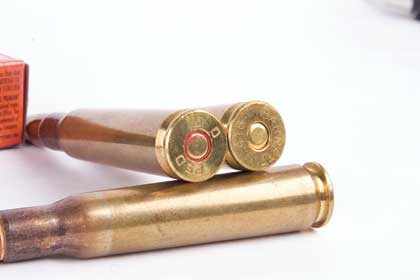 The .416 Barrett has the same case head dimensions as the .50 BMG, so with the exception of the barrel, almost every part of the rifle is the same. |
"Most cartridges, like the 5.56mm, start out with light bullets and get heavier as the ranges get longer," Barrett said. "We started out with a VLD bullet."
Choosing a caliber was easy since the length/weight/shape relationship can be changed to accommodate any caliber. Barrett settled on .416 and started computer modeling different projectiles.
"The caliber already existed, but our barrel makers had never made .416 barrels before," Barrett said. "We wanted a bullet around 400 grains that would fly, and that's the caliber that got us there. The bullet looked good--properly proportioned--and it sounds cool."
Machinists took the drawings and started CNC machining projectiles from a 360 brass alloy, which provided the right amount of mass for the projectile's length and diameter. The final projectile weighed 395 grains. When launched at 3,300 fps, the Barrett VLD Mk. I bullet has a ballistic coefficient of .730 and remains supersonic out to 2,150 yards. Other startling statistics include 9,517 ft-lbs of energy at the muzzle and 3,710 ft-lbs of juice at 1,000 yards. With a full-value, 10-mph crosswind at 1,000 yards, the bullet drifts just 42 inches and is only 124 inches low at that range with a 500-yard zero.
"There are other solid, turned projectiles; we weren't the first," Barrett said. "Ease of manufacture and accuracy were the two most important factors behind this manufacturing method. With a CNC machine, you can have any bullet you want in five minutes, and the projectiles are very consistent, have the same center of gravity, and are very concentric. They are as close to perfect as you can get."
While less expensive and more conventional jacketed bullets are in the works, no current .416-caliber bullets beside the VLD Mk. I will work in the .416 Barrett. They just can't handle the velocity.
Another key design parameter for the cartridge was one that applies to every Barrett product: absolute reliability.
"Our philosophy is and has been reliability first," Barrett said. "Sure we want an accurate rifle, but that is secondary to reliability. It has to send the bullet every time since our rifles our going to serious men who use them in seri
ous situations."
That meant the bullet would need a cannelure, an uncommon feature on VLD bullets. In heavy-recoiling, magazine-fed rifles, bullets can move around in the case neck causing accuracy, pressure, and feeding problems. Barrett said the addition, while unusual, had a negligible effect on the bullet's ability to slip the wind.
The .50 BMG was an obvious starting point for cases. If case head and diameter dimensions remained the same, Barrett could avoid the tedious process of redesigning rifles around the new cartridge. All that would change in current models is the size of the hole in the barrel. The cartridge used a relatively small 204-grain charge of WC 869 powder to achieve the desired muzzle velocity, and that left a lot of unnecessary space in a necked-down .50 BMG case.
"It just didn't make sense to carry all that cartridge around for no reason--who wants to carry a bunch of air?" Barrett said. "We didn't need all that capacity to achieve the velocity we wanted, and we ended up with a cartridge 5/8 inch shorter than the .50 BMG
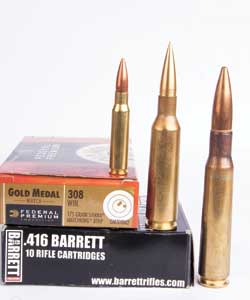 Unlike the 7.62x51mm (left) and the .50 BMG (right), the .416 Barrett (center) was designed from the start as a long-range, precision round and outperforms nearly every cartridge in its class. |
"And there is still room to grow in the shortened case," Barrett added. While the .416 bullets are moving right along, pressures are not maxed out. The current load generates 57,000 psi, and the cartridge has a maximum operating pressure of around 60,000 psi. The case still enjoys a .50 BMG-like taper for reliable feeding and extraction and a sharper shoulder for improved head spacing.
"We didn't want a cartridge that is on the fringe of pressures," Barrett said. "At the end of the day, it just reduces barrel life and reliability."
The new cartridge was first chambered in Barrett's single-shot bolt-action, the Model 99, and has been well received. Currently, the shop is experimenting with a semiautomatic Model 82A1 chambered for the .416 cartridge but has yet to offer barrels to the public. Barrett would not or could not say if the new cartridge was under consideration for adoption by the U.S. military or government agencies. The downside to this success is producing enough ammo to satiate shooters. Barrett currently produces the stuff in-house--it costs $4.69 a shot--but is working on avenues for mass production.
"We are manufacturing the .416 cartridge in-house currently," Barrett said. "It's practically benchrest ammo, every neck is I.D. reamed and chamfered. Some of these processes are not the most cost effective, but they are worth the trouble because the stuff really shoots."
Handloaders can rejoice. Reloading components, namely the VLD Mk. I bullets, are available. Twenty will cost just under $40. The case uses a CCI No. 35 primer and either WC 869 or Hodgdon US 869 will work for propellant. Since pressures are not excessive, case life should be pretty good.
The .416 is fun to shoot and lives up to its extreme long-range potential. The gains in energy, flattened trajectory, and an uncanny ability to slip the wind are simply unmatched by other long-range stalwarts like the .338 Lapua and .50 BMG. The only other cartridge that comes close is the .408 CheyTac, which is even more expensive to shoot.
The .416 At the Range
Currently, the only rifle chambered for the new .416 Barrett cartridge is the single-shot Barrett Model 99. And the rifle is remarkably simple.
A massive aluminum extrusion forms the receiver, and a 32-inch barrel is press fit into place, then locked into the receiver with a barrel nut. A short, 15-lug bolt locks into the barrel extension and sits even with the trigger group when closed, so the overall length is just 50 inches. A long section of steel M1913 rail runs along the top of the receiver for mounting optics. The trigger group is held in place with three pins and can be removed in seconds. The rifle weighs 25 pounds sans optic and has a retail price of $4,130.
To test the cartridge and rifle, I enlisted the help of Banks Behling and Jim Davidoff, both longtime rifle competitors. Banks has shot competitively for 20 years in Palma, high-power, benchrest, and tactical matches, and he has won several class championships and a state championship. None of us had ever fired a .416 Barrett, but we had some experience with .50 BMG-chambered rifles. The Model 99 was equipped with a Leupold Mark 4 4-14X 50mm scope and the Barrett BORS system.
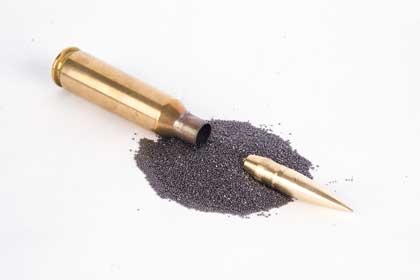 The .416 Barrett uses a 204-grain charge of proprietary propellant. Reloaders can use Hodgdon US 869 or WC 869 to closely mimic factory specs. |
Conditions were typical for a summer morning in Georgia--hot with variable winds up to 15 mph. We zeroed the rifle, per instructions, at 100 yards and then moved out to 500 yards. Ignoring the wind, Behling dialed up 500 yards and sent three quick rounds downrange into an 8-inch group to make sure the BORS was feeding the correct flight-path data to the scope. It was, so we backed up to 810 yards--the longest shot available to us--and settled in for some serious shooting. Behling shot the best three-shot group of the morning; it measured just 5.5 inches center to center. Davidoff's best measured around 8 inches and change. I managed to ignore the advice of a champion shooter watching the mirage and flags and shot my last round into a full-value wind, which stretched my group out to 10.625 inches. Even though we shot Behling's zero, no one put a round off the silhouette target. We all had really just started to settle in with the rifle when our limited ammo supply ran out.
Admittedly, we only scratched the surface of both the round and the rifle's accuracy potential, but we were impressed with what we saw at 800-plus yards. Recoil was a nonfactor, being far less than the .50 BMG. All of our shooting was from the prone position, and finer bipod adjustments would have been nice. Future shoots will probably utilize a rear bag instead of the provided monopod. The trigger broke at an average 5 pounds, 11 ounces, but it was very smooth and manageable.
"For extreme long-range accuracy, the system is just awesome," Behling said. "The rifle is accurate, the round is extremely flat-shooting, and the BORS system was right on the money."
With dies and more bullets on the way, it is now just a matter of finding a 2,000-yard stretch of ground without houses or cows to start a more thorough examination of this high-performance rifle/round combo.
Pros & Cons
Suppose for a minute you are in the "sand box" a
nd have the job of hitting little targets at extreme distances with one round launched from a shoulder-fired rifle. Which cartridge would you choose? Here are the pros and cons of each in a war zone.
After 10 days of watching from a hide filled with scorpions, a tall terrorist attached to a dialysis machine appears outside his cave to catch some rays--the range is extreme. Dial in the range on your BORS and squeeze. Here the .416 Barrett's higher ballistic coefficient and ability to stay supersonic past 2,150 yards makes it inherently more accurate and increases your chances of making the shot of the century.
Rookie spotter? Sniping at any range is a skill that is taught, but it's honed to a razor's edge by experience. The much flatter trajectory and superior wind-slipping ability give it the edge over the .50 BMG if your spotter happens to miss the call by a few clicks. Your miss, though still a miss, will come much closer with the .416.
However, if you run out of ammo with the .50 BMG, simply walk up to the nearest tank or armored vehicle and kindly ask the gunner if you can borrow a couple feet of his .50-caliber ammo. By no means would it be match grade, but after you delink, you are in business.
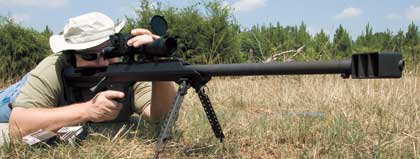 Champion shooter Banks Behling settles in behind the Model 99 on the 800-yard line. He found the rifle/cartridge/optic to be a very accurate and effective combination. |
Shooting a .416? Better hope you have Barrett on speed dial and FedEx delivers to Bagdad because Barrett is currently the only manufacturer of .416 ammo.
Need to shoot a tank? While the .416's monolithic solid bullet is probably one heck of a penetrator, nothing says hello like a specialty round from an M-107. The Mk 211 Raufoss and SLAP rounds are proven fightstoppers, even when your opposition is a BMP.
It will be interesting to see what the future holds for the .416 Barrett. The company could possibly create a new class of long-range rifles based on the cartridge. As more and more rifles and rounds find their way into shooters hands and they experiment to wring out every possible iota of accuracy, it seems the sky is the limit for this new cartridge.

